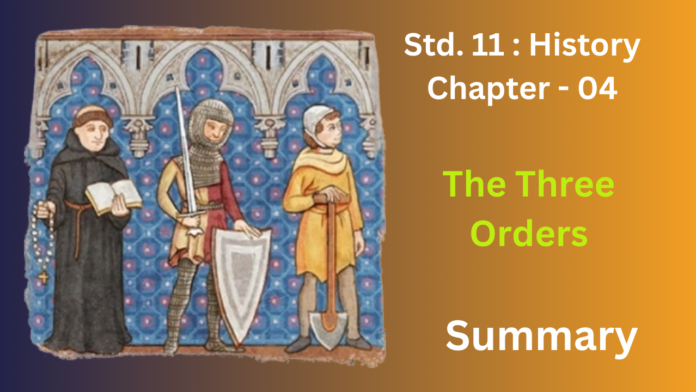This chapter dives into the social structure of Western Europe between the 9th and 16th centuries, a period often referred to as the Middle Ages. It explains the concept of the “three orders” that dominated this society: the clergy (those who prayed), the nobility (those who fought), and the peasantry (those who worked).
The chapter explores the roles and responsibilities of each order. It examines the power and influence of the Church, the privileges and obligations of the feudal lords, and the hard lives and labor of the vast majority of the population – the peasants. You’ll learn about the feudal system, the relationship between lords and vassals, and the economic organization of the manor.
The chapter also discusses how this social structure wasn’t static. It looks at the changes that occurred over time, such as the development of new agricultural technologies, the growth of towns and trade, and the challenges to the established three-order system. It highlights the emergence of new social groups and the factors that eventually led to its decline.
Exercises
ANSWER IN BRIEF
Question 1.
Describe two features of early feudal society in France.
Answer: Early feudal France featured a hierarchical social structure with kings granting land (fiefs) to nobles in exchange for loyalty and military service. Additionally, the manorial system was prevalent, where peasants were tied to the land and provided labor and a share of their produce to the lord of the manor.
Question 2.
How did long-term changes in population levels affect the economy and society in Europe?
Answer:Population Growth:
Economic Expansion: Increased agricultural output supported a growing population, fueling trade and the rise of towns as commercial hubs. More people meant a larger workforce and greater demand for goods.
Urbanization: Cities swelled as people migrated from rural areas, leading to new social structures and ways of life.
Population Decline/Aging:
Economic Challenges: A shrinking workforce can lead to labor shortages, reduced productivity, and slower economic growth. An aging population increases the dependency ratio, straining pension and healthcare systems. Innovation may also decline with a smaller younger population.
Social Shifts: Aging populations can lead to increased demand for care services and potential crises in elder care. Smaller generations may face the burden of supporting a larger retired population. There can also be a decline in social infrastructure in areas experiencing significant population loss.
In recent times, Europe faces the challenge of declining and aging populations, which necessitates policy adjustments to address potential economic stagnation, strain on social welfare systems, and evolving social structures
Question 3.
Why did knights become a distinct group and when did they decline?
Answer:Knights rose to prominence as Europe’s military needs shifted towards heavily armed cavalry around the 8th and 9th centuries. The development of the stirrup, coupled with the need for a mobile fighting force, spurred the creation of a warrior class who could afford horses and armor, often through land grants.Their decline was a gradual process spanning several centuries. The rise of gunpowder and new infantry tactics from the 14th century onwards diminished the battlefield dominance of heavily armored knights. Professional armies became more common, reducing the reliance on feudal levies. Furthermore, evolving social and economic structures lessened the importance of land-based military service. While the ideals of knighthood persisted in chivalry and orders, their role as the primary military force had largely faded by the 16th century.
Question 4.
What was the function of medieval monasteries?
Answer:Medieval monasteries served multiple vital roles. They were centers for prayer and spiritual life, but also crucial hubs for learning, preserving ancient texts, and educating some. They often played a significant economic role through farming and craftsmanship, contributing to the local community’s well-being.
Answer In A Short Essay
Question 5.
Imagine and describe a day in the life of a craftsman in a medieval French town.
Answer:The rooster’s crow, echoing through the narrow, timber-framed streets of Provins, jolted Étienne awake before dawn. As a leatherworker, his day began not with grand pronouncements, but with the familiar scent of tanned hides in his small workshop above the family’s living quarters. The morning chill bit at his fingers as he sorted through supple calfskin, selecting pieces for a merchant’s order of sturdy shoes. Sunlight gradually filtered through the tiny window, illuminating dust motes dancing in the air as he meticulously cut patterns with his well-worn knife.
The rhythmic tap-tap-tap of his hammer against awls and stitching needles punctuated the sounds of the town awakening – the rumble of cartwheels on cobblestones, the chatter of housewives at the communal well, the distant clang of the blacksmith’s forge. Around mid-morning, his young apprentice, Jean-Luc, arrived, eager to learn the trade. Étienne patiently guided his clumsy stitches, sharing the skills passed down through generations.
A simple midday meal of bread, cheese, and perhaps some onion soup, shared with his wife and children, offered a brief respite. Then, back to the bench. The afternoon brought a steady stream of customers: a farmer needing a new belt, a nobleman’s servant requesting repairs to his riding boots, a group of pilgrims seeking durable sandals for their journey. Each interaction was a small thread in the fabric of town life, a testament to the essential role of the craftsman.
As dusk painted the sky in hues of orange and purple, Étienne cleaned his tools, the day’s labor etched in the lines on his hands. The aroma of supper – a pot of stew simmering over the hearth – wafted up from below. Later, perhaps he would share a tankard of ale with fellow artisans at the local tavern, exchanging news and discussing the latest happenings in the town. Finally, weary but satisfied with a day’s honest work, Étienne would climb the narrow stairs to his bed, the sounds of the medieval night – watchman’s calls and distant music – lulling him to sleep, ready to face another day shaping raw materials into articles of necessity and beauty.
Question 6.
Compare the conditions of life for a French serf and a Roman slave.
Answer:Even though both French serfs and Roman slaves toiled under harsh conditions, their experiences were quite distinct.
Think of it this way: a French serf during the feudal era was bound to the land, almost like a tree with roots. They owed their lord a portion of their harvest, their labor for certain days, and often even had to get permission for major life events like marriage. Yet, that very tie to the land offered a sliver of stability. They could build families, and while it was complicated, they sometimes had the ability to hold onto some possessions. Their children, unfortunately, inherited this status.
Now, picture a Roman slave. They were treated as property, plain and simple – like a tool or furniture. They could be bought and sold in a marketplace, moved across vast distances, and put to work in all sorts of jobs, from tending to a household to the brutal conditions of the mines. They had no legal standing, no rights to family life, and no say in their future. However, a crucial difference was that freedom, while not guaranteed and often hard-won, was a possibility. A kind owner might grant it, or a slave might manage to buy their way out. Even then, the shadow of their past often lingered in Roman society.
So, while both groups experienced oppression and a lack of autonomy, the serf’s connection to the land provided a certain rootedness, however restrictive, that the Roman slave, as chattel, simply didn’t have. It’s a powerful reminder that even within systems of domination, the nuances of human experience can be quite different.


